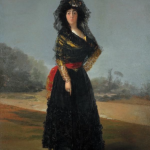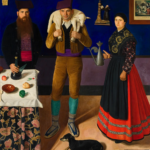El Prado museum to host temporary exhibition of the treasures of the Hispanic Society
When Juan Vespucci drew the first complete image of the world, 500 years ago, he could have never imagined that his Mapa Mundi would be flying around the world from a still not very well traced location in North America. 200 artistic treasures from the most prominent collection of Spanish art outside the Iberian Peninsula have travelled from the home of the Hispanic Society of New York, to dress up the walls of the Prado Museum, from April 4th through September 10th.

Goya, Velázquez, Murillo and Zurbarán will return home – alongside archaeological items, Roman sculptures and other works of art from the 19th and 20th century – in an exhibition entitled “Visions of the Hispanic World. Treasures from the Hispanic Society of America,” sponsored by the BBVA Foundation, which starts its journey 4,000 years ago.
60% of the works that make up the show had never been seen before in Spain, and not by chance. Archer Milton Huntington’s devotion for the Hispanic world was so profound that it moved him to priorities the purchase the works outside Spain in order not to strip that country of its artistic treasures.

The Duchess of Alba (1797), Francisco de Goya y Lucientes.
Milton founded the institution in 1904, giving birth to what today still stands as the most important center for the promotion of Hispanic culture in the United States. Thanks to the fortune he inherited from his father, a railroad magnate and industrialist, he was able to pursue his passion: to bring Hispanic culture to the other side of the Atlantic, and build a public and free center that everybody would be able to visit.
The exhibition at the Prado Museum is a celebration Spain’s artistic splendor. But, above all, it is a tribute to Huntington, who also built close ties with some of the most prominent artist of his era, including Sorolla, whom he commissioned to paint the Regions of Spain series, which was on display in El Prado in 2009.
These paintings have not been included in the exhibition, which does boast other relevant works by Sorolla, mostly portraits of illustrious writers, such as Juan Ramón Jiménez, Pérez Galdós and Pío Baroja. And the light of his Mediterranean beaches will also Grace the Prado Museum.

Sea Idyll (1908), Joaquín de Sorolla y Bastida.
And this great Spanish party would not be complete without some typical Spanish scenes, such as the ones painted by Zuloaga, another good friend of Hungtinton, in The Family of the Gipsy Bullfighter, or Miquel Viladrich in Catalans d’Almatret, the portrait of the Duchess of Alba, Goya’s muse or Velazquez’s Conde Duque de Olivares.
Besides these masterworks from the Golden Century and the 19th and 20th century, the exhibition will also encompass other treasures that tell the history of Spain. From prehistoric items – 4,000 years old – and Roman Sculptures, to Islamic and Christian jewels and medieval texts from Alfonso X of Castile.
The Prado Museum will keep these treasures in custody during five months. After that, they will still have to wait another two years before returning to the permanent seat of the collection, in Manhattan’s upper west side. Meanwhile, they will touring across the United States, as part of a travelling exhibition that will return home once the renovation works of the building conclude in 2019 and the Hispanic Society is able to open its door again to the public.

Catalanes de Almatret (1915), Miguel Viladrich.